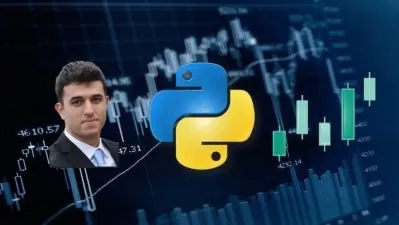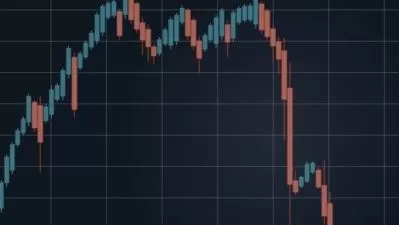The Complete Python Trading Bot Bootcamp (2024 Edition)
13:37:16
Description
Algorithmic Trading on QuantConnect: Master Backtesting and Live Trading with Over 290 Practical Examples
What You'll Learn?
- Code a stock market scanner and use it for trading signals.
- Analyze LIVE news releases of companies for trading signals.
- Trade an unlimited number of stocks with just 1 trading bot.
- Backtest with historical stock data going back to 1998.
- Work with high frequency data up to the second.
- Run your trading bot LIVE with 1-click.
- Use an unlimited number of indicators for entry/exit signals.
- Backtest your trading bot with 1-click.
- Learn multi-functional coding skills that can be applied to multiple asset classes.
- Master backtesting and live trading.
Who is this for?
What You Need to Know?
More details
DescriptionWelcome to The Complete Python Trading Bot Bootcamp (2024 Edition)—the ultimate course to take you from zero to hero in coding trading bots!
Why Learn From Me?
Expert Instruction: As a Fiverr Pro seller, a distinction held by the top 1% of Fiverr sellers, I bring extensive experience in teaching and coding trading bots for over 100 clients, including professionals from major institutions like Credit Suisse and Citibank. With 170 five-star reviews and Top Rated Seller status, my credentials are well-established.
Fiverr profile: licheng906
Certified QuantConnect Integration Partner: As a certified Integration Partner for QuantConnect, a leading open-source, cloud-based algorithmic trading platform for equities, forex, futures, options, derivatives, and cryptocurrencies, I bring expert knowledge to the table.
Why Choose This Course?
Tailored for Everyone: Designed by someone who’s not a computer science guru or Ivy League graduate, this course is taught in plain language with no assumptions about prior knowledge
Versatile Skills: This course focuses on US stocks for simplicity, but the skills you gain are easily transferable to other asset classes, including options, futures, forex, and cryptocurrencies.
No Fluff: Focus on essential Python skills for trading bots, avoiding unnecessary concepts to keep your learning efficient and practical.
Quality Guaranteed: Developed over 3 years and meticulously revised multiple times, this course is thoroughly vetted before launch on Udemy.
Always Up-to-Date: Regularly updated with student feedback, suggestions, and QuantConnect platform changes to ensure the latest content.
Interactive Q&A 100%: I’m committed to your success—expect prompt answers to your questions to enhance your learning experience.
How Is This Course Structured?
Example-Based Learning: Dive into 290+ practical examples that provide hands-on experience with real-world applications.
Comprehensive Coverage: The course is divided into 41 chapters across two main parts—Python essentials and QuantConnect essentials. Start with essential Python skills, then apply them to create and manage trading bots for backtesting and live trading on QuantConnect.
Step-by-Step Progression: Begin with the basics and build your skills incrementally, ensuring a solid understanding before moving on.
All-in-One QuantConnect Tutorial: This course serves as a complete guide to mastering QuantConnect, from fundamentals to advanced applications. If you’re looking for a thorough and practical tutorial, you’ve found it!
Start mastering Python trading bots today and automate your strategies!
Who this course is for:
- A complete beginner in trading seeking a comprehensive algorithmic trading course built on practical, example-based learning focused on real-world applications.
- A seasoned trader looking to supercharge their quantitative research by learning to backtest trading strategies for hundreds, even thousands, of stocks with years of historical data going back to 1998.
- A finance or banking professional looking to break into quantitative finance with a comprehensive course covering direct and alternative data used in quantitative research, including market scanners, news analysis, momentum scanners, and more!
- A programmer with an interest in finance or trading looking to expand their skills into new practical applications within these fields.
- An undergraduate finance major looking to learn how to apply classroom theories to practical applications.
- A fintech entrepreneur seeking to understand the functionalities needed in their product to effectively serve customers.
- Someone familiar with QuantConnect and looking for a detailed QuantConnect tutorial.
- Someone looking to automate their technical analysis for more efficient and consistent trading results.
- Someone looking to backtest and automate their stock trading strategies for better performance.
- Someone who wants to automate and backtest their day trading strategies for improved results.
Welcome to The Complete Python Trading Bot Bootcamp (2024 Edition)—the ultimate course to take you from zero to hero in coding trading bots!
Why Learn From Me?
Expert Instruction: As a Fiverr Pro seller, a distinction held by the top 1% of Fiverr sellers, I bring extensive experience in teaching and coding trading bots for over 100 clients, including professionals from major institutions like Credit Suisse and Citibank. With 170 five-star reviews and Top Rated Seller status, my credentials are well-established.
Fiverr profile: licheng906
Certified QuantConnect Integration Partner: As a certified Integration Partner for QuantConnect, a leading open-source, cloud-based algorithmic trading platform for equities, forex, futures, options, derivatives, and cryptocurrencies, I bring expert knowledge to the table.
Why Choose This Course?
Tailored for Everyone: Designed by someone who’s not a computer science guru or Ivy League graduate, this course is taught in plain language with no assumptions about prior knowledge
Versatile Skills: This course focuses on US stocks for simplicity, but the skills you gain are easily transferable to other asset classes, including options, futures, forex, and cryptocurrencies.
No Fluff: Focus on essential Python skills for trading bots, avoiding unnecessary concepts to keep your learning efficient and practical.
Quality Guaranteed: Developed over 3 years and meticulously revised multiple times, this course is thoroughly vetted before launch on Udemy.
Always Up-to-Date: Regularly updated with student feedback, suggestions, and QuantConnect platform changes to ensure the latest content.
Interactive Q&A 100%: I’m committed to your success—expect prompt answers to your questions to enhance your learning experience.
How Is This Course Structured?
Example-Based Learning: Dive into 290+ practical examples that provide hands-on experience with real-world applications.
Comprehensive Coverage: The course is divided into 41 chapters across two main parts—Python essentials and QuantConnect essentials. Start with essential Python skills, then apply them to create and manage trading bots for backtesting and live trading on QuantConnect.
Step-by-Step Progression: Begin with the basics and build your skills incrementally, ensuring a solid understanding before moving on.
All-in-One QuantConnect Tutorial: This course serves as a complete guide to mastering QuantConnect, from fundamentals to advanced applications. If you’re looking for a thorough and practical tutorial, you’ve found it!
Start mastering Python trading bots today and automate your strategies!
Who this course is for:
- A complete beginner in trading seeking a comprehensive algorithmic trading course built on practical, example-based learning focused on real-world applications.
- A seasoned trader looking to supercharge their quantitative research by learning to backtest trading strategies for hundreds, even thousands, of stocks with years of historical data going back to 1998.
- A finance or banking professional looking to break into quantitative finance with a comprehensive course covering direct and alternative data used in quantitative research, including market scanners, news analysis, momentum scanners, and more!
- A programmer with an interest in finance or trading looking to expand their skills into new practical applications within these fields.
- An undergraduate finance major looking to learn how to apply classroom theories to practical applications.
- A fintech entrepreneur seeking to understand the functionalities needed in their product to effectively serve customers.
- Someone familiar with QuantConnect and looking for a detailed QuantConnect tutorial.
- Someone looking to automate their technical analysis for more efficient and consistent trading results.
- Someone looking to backtest and automate their stock trading strategies for better performance.
- Someone who wants to automate and backtest their day trading strategies for improved results.
User Reviews
Rating

Udemy
View courses Udemy- language english
- Training sessions 617
- duration 13:37:16
- Release Date 2024/11/19










